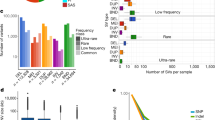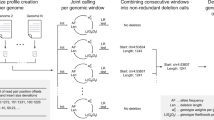Abstract
Inversions, deletions and insertions are important mediators of disease and disease susceptibility1. We systematically compared the human genome reference sequence with a second genome (represented by fosmid paired-end sequences) to detect intermediate-sized structural variants >8 kb in length. We identified 297 sites of structural variation: 139 insertions, 102 deletions and 56 inversion breakpoints. Using combined literature, sequence and experimental analyses, we validated 112 of the structural variants, including several that are of biomedical relevance. These data provide a fine-scale structural variation map of the human genome and the requisite sequence precision for subsequent genetic studies of human disease.
This is a preview of subscription content, access via your institution
Access options
Subscribe to this journal
Receive 12 print issues and online access
$209.00 per year
only $17.42 per issue
Buy this article
- Purchase on SpringerLink
- Instant access to full article PDF
Prices may be subject to local taxes which are calculated during checkout




Similar content being viewed by others
References
Botstein, D. & Risch, N. Discovering genotypes underlying human phenotypes: past successes for mendelian disease, future approaches for complex disease. Nat. Genet. 33 Suppl, 228–237 (2003).
Sebat, J. et al. Large-scale copy number polymorphism in the human genome. Science 305, 525–528 (2004).
Iafrate, A.J. et al. Detection of large-scale variation in the human genome. Nat. Genet. 36, 949–951 (2004).
Gonzalez, E. et al. The influence of CCL3L1 gene-containing segmental duplications on HIV-1/AIDS susceptibility. Science 307, 1434–1440 (2005).
Stefansson, H. et al. A common inversion under selection in Europeans. Nat. Genet. 37, 129–137 (2005).
International Human Genome Sequencing Consortium. Finishing the euchromatic sequence of the human genome. Nature 431, 931–945 (2004).
She, X. et al. Shotgun sequence assembly and recent segmental duplications within the human genome. Nature 431, 927–930 (2004).
Buckland, P.R. Polymorphically duplicated genes: their relevance to phenotypic variation in humans. Ann. Med. 35, 308–315 (2003).
Small, K., Iber, J. & Warren, S. Emerin deletion revals a common X-chromosome inversion mediated by inverted repeats. Nat. Genet. 16, 96–99 (1997).
Colin, Y. et al. Genetic basis of the RhD-positive and RhD-negative blood group polymorphism as determined by Southern analysis. Blood 78, 2747–2752 (1991).
Lackner, C., Cohen, J.C. & Hobbs, H.H. Molecular definition of the extreme size polymorphism in apolipoprotein(a). Hum. Mol. Genet. 2, 933–940 (1993).
Kruglyak, L. & Nickerson, D.A. Variation is the spice of life. Nat. Genet. 27, 234–236 (2001).
Bailey, J.A. et al. Recent segmental duplications in the human genome. Science 297, 1003–1007 (2002).
Locke, D.P. et al. Refinement of a chimpanzee pericentric inversion breakpoint to a segmental duplication cluster. Genome Biol. 4, R50 (2003).
Brewer, C., Holloway, S., Zawalnyski, P., Schinzel, A. & FitzPatrick, D. A chromosomal duplication map of malformations: regions of suspected haplo- and triplolethality—and tolerance of segmental aneuploidy—in humans. Am. J. Hum. Genet. 64, 1702–1708 (1999).
Lindsley, D.L. et al. Segmental aneuploidy and the genetic gross structure of the Drosophila genome. Genetics 71, 157–184 (1972).
Snijders, A.M. et al. Assembly of microarrays for genome-wide measurement of DNA copy number. Nat. Genet. 29, 263–264 (2001).
Horvath, J., Schwartz, S. & Eichler, E. The mosaic structure of a 2p11 pericentromeric segment: A strategy for characterizing complex regions of the human genome. Genome Res. 10, 839–852 (2000).
Eichler, E.E. et al. Length of uninterrupted CGG repeats determines stability in the FMR1 gene. Nat. Genet. 8, 88–94 (1994).
Badge, R.M., Alisch, R.S. & Moran, J.V. ATLAS: a system to selectively identify human-specific L1 insertions. Am. J. Hum. Genet. 72, 823–838 (2003).
Wong, G.K., Yu, J., Thayer, E.C. & Olson, M.V. Multiple-complete-digest restriction fragment mapping: generating sequence-ready maps for large-scale DNA sequencing. Proc. Natl. Acad. Sci. USA 94, 5225–5230 (1997).
Thompson, J.D., Higgins, D.G. & Gibson, T.J. CLUSTAL W: improving the sensitivity of progressive multiple sequence alignment through sequence weighting, position-specific gap penalties and weight matrix choice. Nucleic Acids Res. 22, 4673–4680 (1994).
Sprenger, R. et al. Characterization of the glutathione S-transferase GSTT1 deletion: discrimination of all genotypes by polymerase chain reaction indicates a trimodular genotype-phenotype correlation. Pharmacogenetics 10, 557–565 (2000).
McLellan, R.A., Oscarson, M., Seidegard, J., Evans, D.A. & Ingelman-Sundberg, M. Frequent occurrence of CYP2D6 gene duplication in Saudi Arabians. Pharmacogenetics 7, 187–191 (1997).
Aklillu, E. et al. Frequent distribution of ultrarapid metabolizers of debrisoquine in an ethiopian population carrying duplicated and multiduplicated functional CYP2D6 alleles. J. Pharmacol. Exp. Ther. 278, 441–446 (1996).
Koppens, P.F., Hoogenboezem, T. & Degenhart, H.J. Duplication of the CYP21A2 gene complicates mutation analysis of steroid 21-hydroxylase deficiency: characteristics of three unusual haplotypes. Hum. Genet. 111, 405–410 (2002).
Lee, E.J., Wong, J.Y., Yeoh, P.N. & Gong, N.H. Glutathione S–transferase-θ (GSTT1) genetic polymorphism among Chinese, Malays and Indians in Singapore. Pharmacogenetics 5, 332–334 (1995).
Acknowledgements
We thank C. Alkan, J. Sprague, C. Gulden, D. Locke, S. McGrath and Z. Cheng for technical assistance and A. Chakravarti and B. Waterston for comments. This work was supported, in part, by a grant from the US National Institutes of Health to E.E.E.
Author information
Authors and Affiliations
Corresponding author
Ethics declarations
Competing interests
The authors declare no competing financial interests.
Supplementary information
Supplementary Fig. 1
Fosmid size distribution. (PDF 46 kb)
Supplementary Fig. 2
Chromosomal views of structural variation (chromosomes 1 through Y inclusive). (PDF 458 kb)
Supplementary Fig. 3
Chromosomal views of structural variation (chromosomes 1 through Y inclusive). (PDF 452 kb)
Supplementary Fig. 4
Chromosomal views of structural variation (chromosomes 1 through Y inclusive). (PDF 368 kb)
Supplementary Fig. 5
Chromosomal views of structural variation (chromosomes 1 through Y inclusive). (PDF 370 kb)
Supplementary Fig. 6
Chromosomal views of structural variation (chromosomes 1 through Y inclusive). (PDF 345 kb)
Supplementary Fig. 7
Chromosomal views of structural variation (chromosomes 1 through Y inclusive). (PDF 320 kb)
Supplementary Fig. 8
Chromosomal views of structural variation (chromosomes 1 through Y inclusive). (PDF 326 kb)
Supplementary Fig. 9
Chromosomal views of structural variation (chromosomes 1 through Y inclusive). (PDF 267 kb)
Supplementary Fig. 10
Chromosomal views of structural variation (chromosomes 1 through Y inclusive). (PDF 250 kb)
Supplementary Fig. 11
Chromosomal views of structural variation (chromosomes 1 through Y inclusive). (PDF 264 kb)
Supplementary Fig. 12
Chromosomal views of structural variation (chromosomes 1 through Y inclusive). (PDF 252 kb)
Supplementary Fig. 13
Chromosomal views of structural variation (chromosomes 1 through Y inclusive). (PDF 260 kb)
Supplementary Fig. 14
Chromosomal views of structural variation (chromosomes 1 through Y inclusive). (PDF 197 kb)
Supplementary Fig. 15
Chromosomal views of structural variation (chromosomes 1 through Y inclusive). (PDF 180 kb)
Supplementary Fig. 16
Chromosomal views of structural variation (chromosomes 1 through Y inclusive). (PDF 193 kb)
Supplementary Fig. 17
Chromosomal views of structural variation (chromosomes 1 through Y inclusive). (PDF 178 kb)
Supplementary Fig. 18
Chromosomal views of structural variation (chromosomes 1 through Y inclusive). (PDF 184 kb)
Supplementary Fig. 19
Chromosomal views of structural variation (chromosomes 1 through Y inclusive). (PDF 144 kb)
Supplementary Fig. 20
Chromosomal views of structural variation (chromosomes 1 through Y inclusive). (PDF 149 kb)
Supplementary Fig. 21
Chromosomal views of structural variation (chromosomes 1 through Y inclusive). (PDF 115 kb)
Supplementary Fig. 22
Chromosomal views of structural variation (chromosomes 1 through Y inclusive). (PDF 81 kb)
Supplementary Fig. 23
Chromosomal views of structural variation (chromosomes 1 through Y inclusive). (PDF 90 kb)
Supplementary Fig. 24
Chromosomal views of structural variation (chromosomes 1 through Y inclusive). (PDF 297 kb)
Supplementary Fig. 25
Chromosomal views of structural variation (chromosomes 1 through Y inclusive). (PDF 80 kb)
Supplementary Fig. 26
Sequence properties of segmental duplications associated with structural variants. (PDF 15 kb)
Supplementary Fig. 27
L1 HS insertions and deletions. (PDF 54 kb)
Supplementary Fig. 28
Validated structural polymorphisms. (PDF 152 kb)
Supplementary Table 1
Summary details of detected structural variants and fosmid pairs spanning gaps within the sequence assembly. (XLS 303 kb)
Supplementary Table 2
Array CGH using BAC surrogates over sites of structural variation detected by fosmid paired-ends. (XLS 1274 kb)
Supplementary Table 3
Summary of fosmid sequencing. (XLS 31 kb)
Supplementary Table 4
PCR genotyping assays for structural variation. (XLS 19 kb)
Supplementary Table 5
Allele frequencies for seven structural polymorphisms validated by PCR. (XLS 19 kb)
Rights and permissions
About this article
Cite this article
Tuzun, E., Sharp, A., Bailey, J. et al. Fine-scale structural variation of the human genome. Nat Genet 37, 727–732 (2005). https://doi.org/10.1038/ng1562
Received:
Accepted:
Published:
Issue Date:
DOI: https://doi.org/10.1038/ng1562
This article is cited by
-
Mutational landscape of HSP family on human breast cancer
Scientific Reports (2024)
-
Characterization of the immunoglobulin lambda chain locus from diverse populations reveals extensive genetic variation
Genes & Immunity (2022)
-
Frequency and clinical significance of chromosomal inversions prenatally diagnosed by second trimester amniocentesis
Scientific Reports (2022)
-
Effects of Long-Term In Vitro Expansion on Genetic Stability and Tumor Formation Capacity of Stem Cells
Stem Cell Reviews and Reports (2022)
-
Megabase-scale presence-absence variation with Tripsacum origin was under selection during maize domestication and adaptation
Genome Biology (2021)



